Vesta is among the most significant objects in the asteroid belt. It is the second-most massive and possibly the second-largest asteroid after the dwarf planet Ceres.
Key Facts & Summary
- 4 Vesta has a diameter of around 525 kilometers / 326 miles.
- The asteroid constitutes around 9% of the mass of the asteroid belt.
- In comparison with other asteroids, Vesta is slighter larger than Pallas; however, it is 25% more massive.
- Among the other remaining rocky protoplanets, Vesta is the only one with a differentiated interior, very similar to the one that formed the terrestrial planets.
- This colossal asteroid was discovered in 1807 by the German astronomer Heinrich Wilhelm Matthias Olbers.
- Because of numerous collisions, Vesta lost various fragments from itself around two billion years ago.
- There are two enormous craters on Vesta’s southern hemisphere, which evidence this.
- These events don’t go by without creating further causalities. Much of the debris from then have fallen to Earth as the howardite-eucrite-diogenite meteorites.
- This debris has been an enormous source of information regarding Vesta’s composition.
- Vesta is also the brightest asteroid visible from Earth, having an apparent magnitude of 5.1 to 8.48.
- The asteroid’s absolute magnitude has been estimated to be at 3.20.
- Vesta has been classified as a spectral type V celestial object.
- The temperatures on Vesta have been calculated to be at 85 K at minimum, and at 270 K at maximum.
- The orbit of Vesta lies entirely within that of Ceres.
- The maximum distance of Vesta from the Sun is slightly higher than the minimum length of Ceres from the Sun.
- The famous spacecraft Dawn entered Vesta’s orbit in 2011 and left one year later to continue its mission to the largest asteroid known to us, Ceres.
Vesta is one of the four largest asteroids, the others being Ceres, Pallas, and Hygiea. It is the first asteroid to be visited by a spacecraft, and it is the brightest asteroid in the night sky, sometimes being visible even to the naked eye.
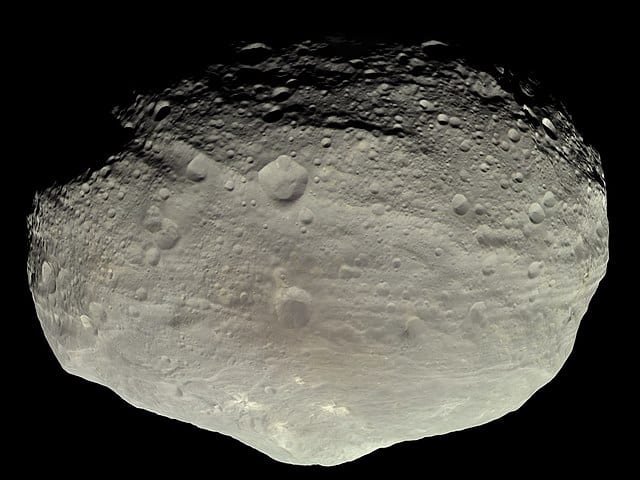
It is designated as 4 Vesta since it is the fourth discovered asteroid. The name Vesta comes from Roman mythology; she was the goddess of home and hearth. The man who named the asteroid was the German mathematician Carl Friedrich Gauss.
He played a considerable role in the discovery of Vesta and, as such, was given the honor of naming the celestial object. Another reason why he named it was because the German astronomer Heinrich Olbers who already named and discovered Pallas and Ceres in 1801-2, handed this honor to him.
Formation
Vesta formed early after the birth of the solar system, more specifically at around 1 to 2 million years after. The celestial object appears to have a crust, mantle, and core very similar to our Earth; hence it is differentiated from other asteroids.
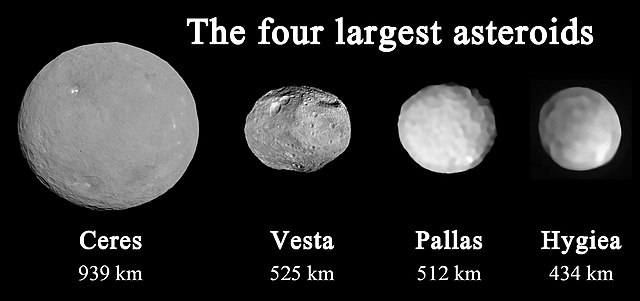
This is related to its early formation; the short-lived radioactive materials were incorporated into bodies during their formation in that epoch, and they were heated to the point where objects melted, and this allowed for denser materials to sink to the asteroid’s core and the lower density materials were permitted to rise.
Shape, Surface, and Geology
Vesta’s surface is covered in bright and dark materials similar to our Moon. The asteroid has basaltic regions indicating that lava once flowed across the surface.
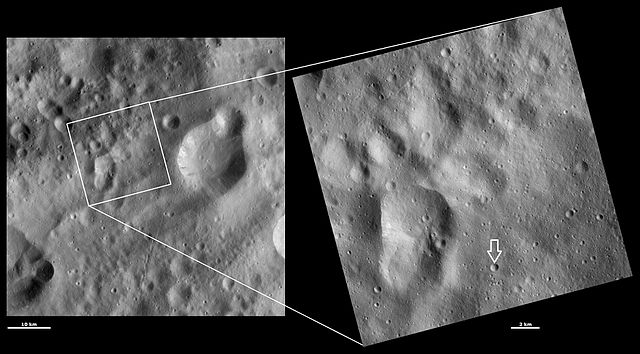
The shape of Vesta is quite irregular, roughly that of an oblate spheroid. A gigantic crater with a diameter of 460 km / 285 mi has been observed on its surface; in comparison, the whole asteroid is only 530 km / 329 mi across.
It cuts around 13 km / 8 mi into its crust and most likely suggests that it formed during a powerful collision. As a result of this collision, the material ejected from Vesta became smaller Vestoids – asteroids that orbit near their parent, some of which crashed into Earth as meteorites.
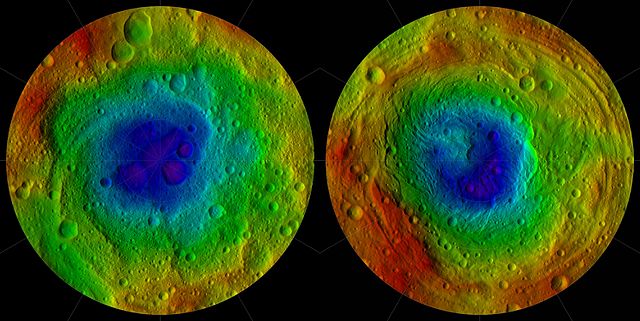
There are many mountain towers over Vesta’s southern pole. They reach up over 65.000 feet / 20 kilometers in height, almost as tall as Olympus Mons, the largest mountain/volcano in the solar system. The data collected from Dawn revealed the fact that liquid water once flowed on the surface of Vesta.
Since the asteroid has no atmosphere and low temperatures, the water evaporated, but ice may be buried under its surface.
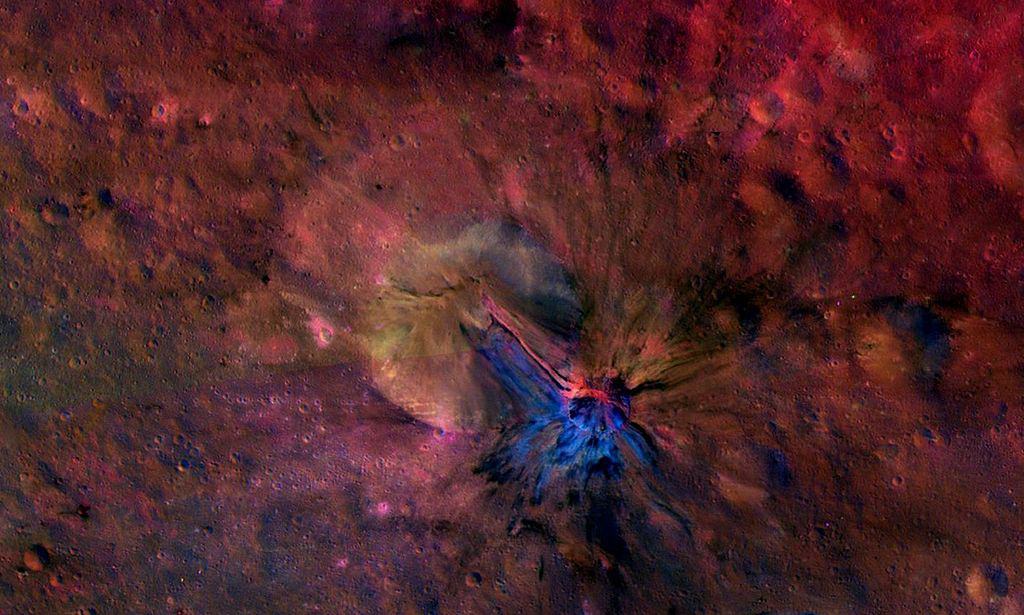
Composition
Vesta’s interior is quite different than most asteroids. It is very similar to that of the terrestrial planets. It has a crust of cooled lava covering a rocky mantle and an iron/nickel core.
It is speculated that the core accreted within the first 10 million years after the formation of the solar system. Vesta’s basaltic crust also formed in millions of years. The volcanic eruptions stemmed from the mantle, lasting for tens of hours.
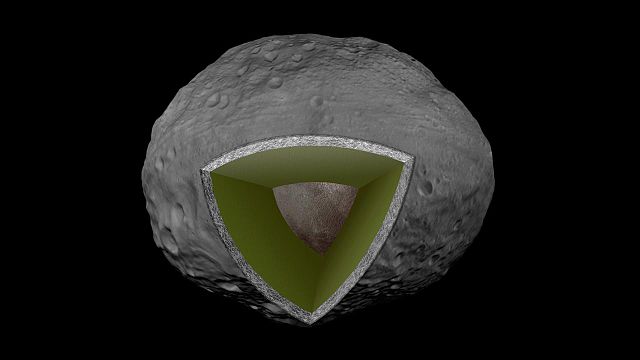
After the lava cooled rapidly, it was buried again by more lava until the crust was complete. The core is believed to make up around 18% of Vesta’s entire mass or two-thirds as massive as Earth’s core.
The pieces of Vesta that had fallen on Earth revealed the presence of pyroxene, a mineral found in lava flows. Vesta itself has a vast amount of hydrogen on its surface.
Orbit and Rotation
Between Mars and Jupiter, Vesta orbits the Sun within the asteroid belt within 3.6 years, specifically in the inner asteroid belt, interior to the Kirkwood gap at 2.50 AU.
Vesta has a moderately inclined orbit 7.1 degrees, but also eccentric 0.09 – similar to Mars. Vesta can sometimes capture other asteroids into temporary 1:1 resonant orbital relationships for periods of up to 2 million years or more. Currently, forty such companions have been found.
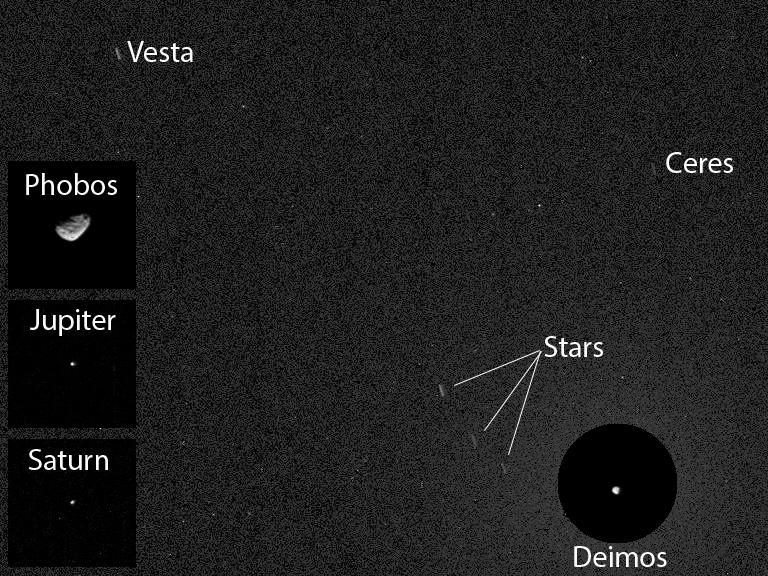
Vesta is also a fast spinner, even for an asteroid. It has a prograde rotation, and its axial tilt has been speculated to be at 29 degrees. At aphelion, Vesta is 2.5 AU away from the Sun while at perihelion, 2.1 AU.
Other Characteristics
Being the second-most-massive body in the asteroid belt, Vesta is 28% as massive as Ceres. Its density is the lowest out of the four terrestrial planets but higher than all the moons (except for Io), and most asteroids in the solar system.

The surface area of Vesta is almost the same as that of Pakistan – around 800.000 square kilometers / 497.096 miles. It is 25% more massive than Pallas, though only slightly larger.
Analysis of Vesta’s shape and gravity determined that the celestial object is currently not in hydrostatic equilibrium.
The Future
Studying Vesta will continue to be a priority for scientists for many years to come. We can learn much about how protoplanets or terrestrial planets form even better, and what can interfere in this process.
Did you know?
- No further objects were discovered for nearly 38 years after Vesta, and the solar system was thought to have 11 planets.
- If Jupiter’s presence had been somehow dismissed, Vesta would have most likely successfully developed into a small planet.
- Fracture lines along Vesta’s equator suggest it came close to shattering at one point in time.
- Vesta holds much valuable information that could help us understand many things about our planet.
Sources:
Image sources:
- https://upload.wikimedia.org/wikipedia/commons/thumb/d/dc/Vesta_in_natural_color_%28cropped%29.jpg/640px-Vesta_in_natural_color_%28cropped%29.jpg
- https://upload.wikimedia.org/wikipedia/commons/thumb/8/86/The_Four_Largest_Asteroids.jpg/640px-The_Four_Largest_Asteroids.jpg
- https://upload.wikimedia.org/wikipedia/commons/thumb/a/a0/Claudia_crater%2C_Vesta_IOTD-298.jpg/640px-Claudia_crater%2C_Vesta_IOTD-298.jpg
- https://upload.wikimedia.org/wikipedia/commons/thumb/5/58/Vesta_northern_and_southern_hemispheres_pia15677.jpg/640px-Vesta_northern_and_southern_hemispheres_pia15677.jpg
- https://upload.wikimedia.org/wikipedia/commons/thumb/e/e6/PIA17661-NASA-DawnMission-Asteroid-Vesta-20131216.jpg/1024px-PIA17661-NASA-DawnMission-Asteroid-Vesta-20131216.jpg
- https://upload.wikimedia.org/wikipedia/commons/thumb/5/57/Vestan_interior_PIA15510.jpg/640px-Vestan_interior_PIA15510.jpg
- https://upload.wikimedia.org/wikipedia/commons/2/2c/PIA17937-MarsCuriosityRover-FirstAsteroidImage-20140420.jpg
- https://upload.wikimedia.org/wikipedia/commons/thumb/c/cd/Vesta_Snowman_craters.jpg/640px-Vesta_Snowman_craters.jpg
